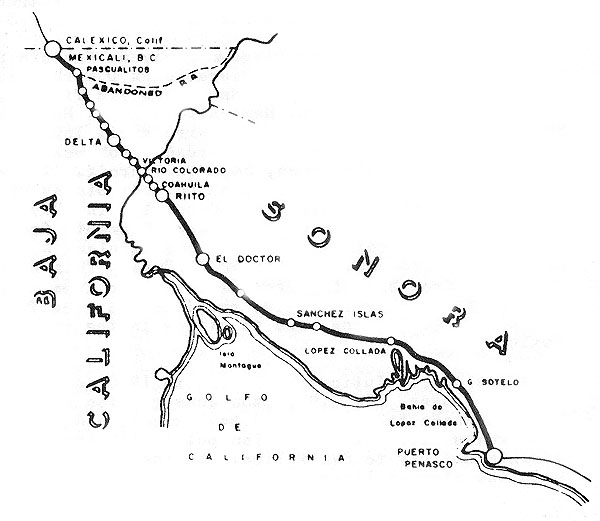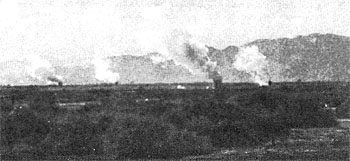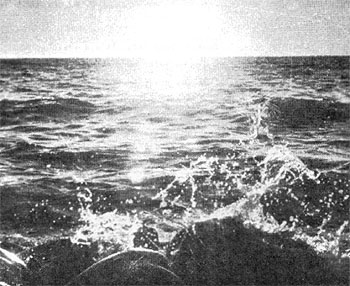Work on the railroad began in 1923 and about 10 miles of track were laid to a point just south of the present station of Lobo. This road was known as the Ferrocarril Mexicali y Golfo. A 1926 map shows "end of track" 23 miles from Pascualitos. The operation of work trains was started and small amounts of cotton were hauled.
Subsequently an agreement was concluded with the Colorado River Land Company, which had obtained possession of the farm lands and constituted a monopoly which did not want the "communacion de Baja California—nia con el interior de Mexico," and the route was detoured to cross the Colorado River.
In 1929, the Ferrocarril Inter-California del Sur took over the project. The line was extended, through Riito to just beyond Medanos. The revised railroad map indicates the end of track in March 1930 as there. The Southern Pacific purchased control of the Inter-California Southern in 1930, and according to its record, the line to Medanos was not opened until October 1931.
The rail front remained at Medanos until 1937. There was no intention prior to 1935 to connect it with Mexico's national network.
The Southern Pacific had acquired the Sonora Railway from the Santa Fe from Nogales to Guayamas in 1911. Using the name Ferrocarril Sur Pacifico de Mexico, it has extended the route to Guadalajara to connect with the National Railways of Mexico.
With the development of the Mexicali Valley, the urgent need for an all-Mexican rail route was now acknowledged. Shipments to the interior had to be made "in bond" with customs inspections at Cantu and Nogales. The creation of a railroad, which was destined to vitalize the northern part of Baja, through the Secretaria de Communicaciones y Obras Publicas, S.C.O.P. - or the department or Ministry of Communications and Public Works, in 1935. This was the origin of the Ferrocaril Sonora-Baja California, a wholly government-owned railway but not included in the Ferrocarriles Nacionales de Mexico.
Beginning at Medanos, location surveys were started, heading for Puerto Penasco, on the eastern shore of the Gulf of California. The project was carried to completion in November 1936. When the town of El Doctor, about 58 miles from Pascualitos, the edge of the Desierto de Altar was reached and the task became a formidable one.
The rail head advanced to El Doctor and then plunged into the desolate region of sand dunes, heat and wind. At Kilometer 132 a camp, called El Alamo, was setup. It was felt that possibly the origina1 survey could be improved by straightening and shortening the staked line. A party headed by a young engineer Jorge Lopez Collado started out on July 2, 1937. The men never returned, falling victims to the cruel desert. Today four stations between El Doctor and Puerto Penasco have been named in their honor Sanchez Islas, Torres B., Lopez Collado and Gustavo Sotelo. In 1940, the rails reached Puerto Penasco and the transportation of freight and passengers began on May 5, 1940.


NATURAL STEAM. . .Natural steam wells are seen along the tracks as our
special PSRMA train moves briefly inland.
Following the war, preparations were begun to complete the connection with the Southern Pacific of Mexico. The forbidding Altar Desert still had to be conquered between Puerto Penasco and Caborca, approximately 248 miles. Steam engines require water and this would have to be carried into the desert. However, by now the diesel electric locomotives had been sufficiently perfected and were rapidly replacing the steamers.
The desert held true to its history, the work had to be done only in the early morning and late evening hours. However improved methods and increased mechanization methods speeded the job of conquering the desert.
Original plans called for a junction with the Southern Pacific of Mexico at Santa Ana, in Sonora, about 65 miles south of Nogales. A later line change determined the meeting point to be at the hacienda de San Fernando, not even a flag stop on the SPdeM. The junction was given the name Benjamin Hill. The railroad's shops have been built there and Benjamin hill is the "new flower of the desert".
Finally came the long awaited day, amid wild jubilation of the workmen, at Kilometer 327 of 203 miles from Pascualitos, in the profundity of the awful desiprto de Altar, the ends of the two tracks were joined together on December 16, 1947. For the first time the peninsula of Baja California was united directly by rail with the national network.
The Sonora-Baja California has broken the barrier of the Desert of Altar by binding it with two bands of glistening steel but it still bows to the torrid heat by operating its passenger service by night, despite the modern air-conditioned equipment.
(This history of the FSBC was condensed from an article by Richard V.Dodge which appeared in the March 20, 1960 edition of the DISPATCHER, a publication of the Railway Historical Society of San Diego.)

SEA OF CORTEZ...Wave breaks on the rocky shore at the edge of Puerto Penasco.
The village lies on the coast.